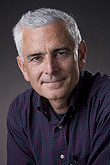JDEM: Je t'aime, je ne t'aime pas
Craig Hogan, the head of the Center for Particle Astrophysics, wrote this week’s column.
 |
| Craig Hogan |
In recent years, Fermilab's long-term strategic vision has included a leading role in JDEM, the proposed Joint Dark Energy Mission satellite. Scientists thought the space-based mission, funded jointly by NASA and the Department of Energy, was the best option to explore dark energy, the mysterious force that drives the universe apart.
Now it looks like JDEM might not have the field to itself. A report of HEPAP's Particle Astrophysics Science Assessment Group, presented at the HEPAP meeting last month, cautions that even in the most optimistic budget scenarios, future dark energy studies need to be "executed through the most cost-effective combination of ground and space approaches."
What's going on here? Only two years ago, a high-profile National Research Council study on NASA's Beyond Einstein program gave JDEM its blessing: "A JDEM mission selected in 2009 could proceed smoothly to a timely and successful launch." That hasn't happened.
The reason for PASAG's caution is simple. The last two years of mission studies have shown that a wide-field, detailed cosmic survey with a large, space-based telescope, multiple modalities, gigabyte detectors and petabytes of data is very expensive. It seems that we can get many answers more quickly with a balanced program that includes cost-effective ground-based programs such as the Large Synoptic Survey Telescope or BigBOSS, a large spectroscopic survey. These projects are like souped-up versions of the Sloan Digital Sky Survey and the Dark Energy Survey that Fermilab is working on now, and they seem to offer faster and cheaper ways to find out why the universe is accelerating.
Last month, NASA put out a call for scientists to work on plans for a smaller, cheaper JDEM, and Fermilab astrophysicists have applied. Although it likely won't be the comprehensive survey mission many dreamed of, JDEM still could make some critical measurements from space that are impossible from the ground.
The science goals for dark energy research remain compelling. We'll know more about the shape of the future program after Astro2010, the ongoing Decadal Survey in Astronomy and Astrophysics by the National Research Council, delivers its verdict on priorities for many large projects next summer.
|